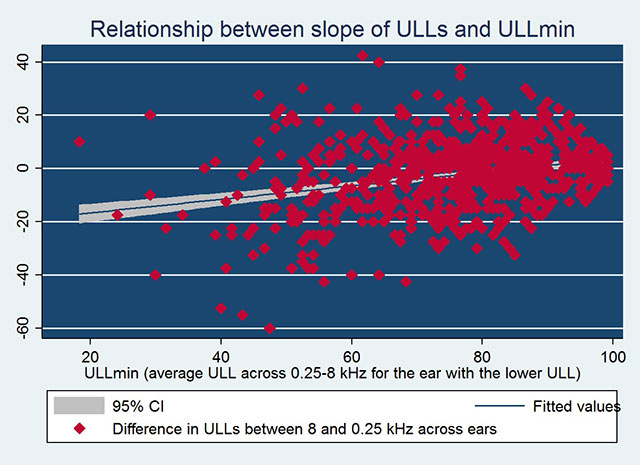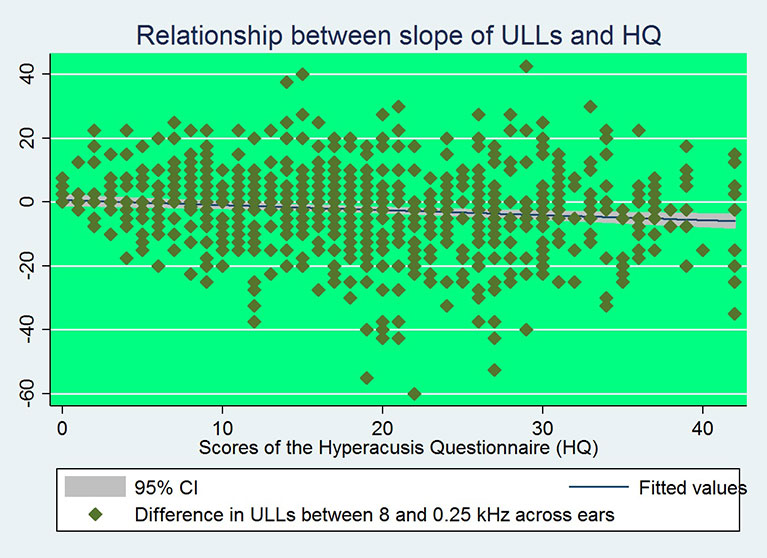Variation in Uncomfortable Loudness Levels (ULLs) across frequency: A marker of misophonia and severe hyperacusis
Across-frequency variations in Uncomfortable Loudness Levels (ULLs) have not been fully explored in audiology literature. Most researchers reported that ULLs averaged across participants did not change markedly across the frequency range (Formby et al. 2007; Meeus et al. 2010; Sheldrake et al. 2015). However, they did not report the ULL variations across frequency for individual patients.
Dr. Aazh’s tinnitus team and their international collaborators conducted a pioneering study analysing the data for over 900 patients in order to explore the pattern of ULLs among patients with tinnitus and hyperacusis. They assessed the “slope of the ULL thresholds” by calculating the mean differences in ULLs between 8 and 0.25 kHz (i.e., ULL at 8 kHz minus ULL at 0.25 kHz). Their study showed that there was a significant correlation between the slope of the ULLs (difference between ULL at 8 kHz and 0.25 kHz) and ULLmin (Average ULL across 0.25, 0.5, 1, 2, 4 and 8 kHz for the ear with the lower average ULL) (r=0.3, p<0.001). There was a significant negative correlation between the slope of the ULLs (8 – 0.25 kHz) and the scores on Hyperacusis Questionnaire (HQ) (r=-0.13, p=0.001). In the other words, patients with steeper ULLs (larger differences in ULLs thresholds between 0.25 and 8 kHz) had lower average ULLs in their worse ears and greater hyperacusis handicap.


The ULL slope (difference between ULL at 8 kHz and 0.25 kHz) was ≥20 dB in 115 out of 1004 patients (11.45%).
The mean score on the HQ was 22 (SD = 8.9) for patients with the absolute slope of the ULLs across ears ≥20 dB (n = 115). This HQ score was significantly higher (worse) than the HQ score of 17 (SD = 9.7) for patients with absolute ULL slope across ears <20 dB (n = 888) (p<0.001). Thus, large across-frequency changes in ULL are associated with poorer HQ scores.
The average of ULLmin (Average ULL across 0.25, 0.5, 1, 2, 4 and 8 kHz for the ear with the lower average ULL) was 66 dB HL(SD = 15.4) for patients with the absolute slope of the ULLs (difference between ULL at 8 kHz and 0.25 kHz) across ears ≥20 dB (n = 115). This was significantly lower (worse) than the ULLmin of 80.6 dB HL (SD = 13.1) for patients with absolute ULL slope across ears <20 dB (n = 888) (p<0.001). Thus, large across-frequency changes in ULL are associated with more severe hyperacusis based on ULLmin.
Approximately 22% of the patients with the slope of the ULLs (difference between ULL at 8 kHz and 0.25 kHz) across ears ≥20 dB were diagnosed with severe hyperacusis as indicated by ULL of 30 dB HL or less is measured for at least one of frequency from 0.25, 0.5, 1, 2, 3, 4, 6, and 8 kHz, for at least one ear (Aazh & Moore 2018). This is significantly higher than the 2% who were diagnosed with severe hyperacusis among patients with ULL slope across ears <20 dB (p<0.001).
This study, for the first time, highlights that server hyperacusis and greater hyperacusis handicap is characterized by strong across-frequency variations in ULL.
The strong across-frequency variations in ULLs for our patients is an indication of adverse reactions only to specific sounds, which is consistent with the definitions of annoyance and fear hyperacusis (Tyler et al. 2014) and misophonia (Cavanna & Seri 2015; Kumar et al. 2017; Jastreboff & Jastreboff 2014).
References
Aazh, H., & Moore, B. C. J. (2018). Prevalence and characteristics of patients with severe hyperacusis among patients seen in a tinnitus and hyperacusis clinic Journal of American Academy of Audiology, 29, 626-633.
Cavanna, A. E., & Seri, S. (2015). Misophonia: current perspectives. Neuropsychiatr Dis Treat, 11, 2117-23.
Formby, C., Gold, S. L., Keaser, M. L., et al. (2007). Secondary benefits from tinnitus retraining therapy: clinically significant increases in loudness discomfort level and expansion of the auditory dynamic range. . Semin Hear, 28, 227-260.
Jastreboff, P. J., & Jastreboff, M. M. (2014). Treatments for Decreased Sound Tolerance (Hyperacusis and Misophonia). In Seminars in Hearing, 35 (pp. 105-120).
Kumar, S., Tansley-Hancock, O., Sedley, W., et al. (2017). The Brain Basis for Misophonia. Current Biology, 1-7.
Meeus, O. M., Spaepen, M., Ridder, D. D., et al. (2010). Correlation between hyperacusis measurements in daily ENT practice. Int J Audiol, 49, 7-13.
Sheldrake, J., Diehl, P. U., & Schaette, R. (2015). Audiometric characteristics of hyperacusis patients. Front Neurol, 6, 105.
Tyler, R. S., Pienkowski, M., Rojas Roncancio, E., et al. (2014). A review of hyperacusis and future directions: part I. definitions and manifestations. American Journal of Audiology, 23, 402-419.
Read MoreCookie settings
REJECTACCEPT
Privacy Overview
| Cookie | Duration | Description |
|---|---|---|
| __stripe_mid | 1 year | Stripe sets this cookie cookie to process payments. |
| __stripe_sid | 30 minutes | Stripe sets this cookie cookie to process payments. |
| cookielawinfo-checkbox-advertisement | 1 year | Set by the GDPR Cookie Consent plugin, this cookie is used to record the user consent for the cookies in the "Advertisement" category . |
| cookielawinfo-checkbox-analytics | 11 months | This cookie is set by GDPR Cookie Consent plugin. The cookie is used to store the user consent for the cookies in the category "Analytics". |
| cookielawinfo-checkbox-functional | 11 months | The cookie is set by GDPR cookie consent to record the user consent for the cookies in the category "Functional". |
| cookielawinfo-checkbox-necessary | 11 months | This cookie is set by GDPR Cookie Consent plugin. The cookies is used to store the user consent for the cookies in the category "Necessary". |
| cookielawinfo-checkbox-others | 11 months | This cookie is set by GDPR Cookie Consent plugin. The cookie is used to store the user consent for the cookies in the category "Other. |
| cookielawinfo-checkbox-performance | 11 months | This cookie is set by GDPR Cookie Consent plugin. The cookie is used to store the user consent for the cookies in the category "Performance". |
| viewed_cookie_policy | 11 months | The cookie is set by the GDPR Cookie Consent plugin and is used to store whether or not user has consented to the use of cookies. It does not store any personal data. |
| Cookie | Duration | Description |
|---|---|---|
| _ga | 2 years | The _ga cookie, installed by Google Analytics, calculates visitor, session and campaign data and also keeps track of site usage for the site's analytics report. The cookie stores information anonymously and assigns a randomly generated number to recognize unique visitors. |
| _gat_gtag_UA_131443801_1 | 1 minute | Set by Google to distinguish users. |
| _gid | 1 day | Installed by Google Analytics, _gid cookie stores information on how visitors use a website, while also creating an analytics report of the website's performance. Some of the data that are collected include the number of visitors, their source, and the pages they visit anonymously. |
| CONSENT | 2 years | YouTube sets this cookie via embedded youtube-videos and registers anonymous statistical data. |
| Cookie | Duration | Description |
|---|---|---|
| VISITOR_INFO1_LIVE | 5 months 27 days | A cookie set by YouTube to measure bandwidth that determines whether the user gets the new or old player interface. |
| YSC | session | YSC cookie is set by Youtube and is used to track the views of embedded videos on Youtube pages. |
| yt-remote-connected-devices | never | YouTube sets this cookie to store the video preferences of the user using embedded YouTube video. |
| yt-remote-device-id | never | YouTube sets this cookie to store the video preferences of the user using embedded YouTube video. |
| yt.innertube::nextId | never | This cookie, set by YouTube, registers a unique ID to store data on what videos from YouTube the user has seen. |
| yt.innertube::requests | never | This cookie, set by YouTube, registers a unique ID to store data on what videos from YouTube the user has seen. |
| Cookie | Duration | Description |
|---|---|---|
| m | 2 years | No description available. |
